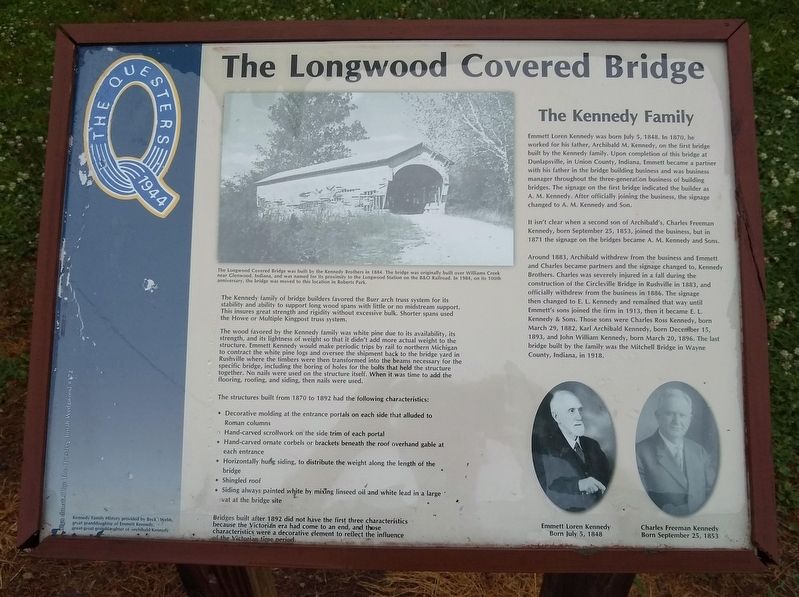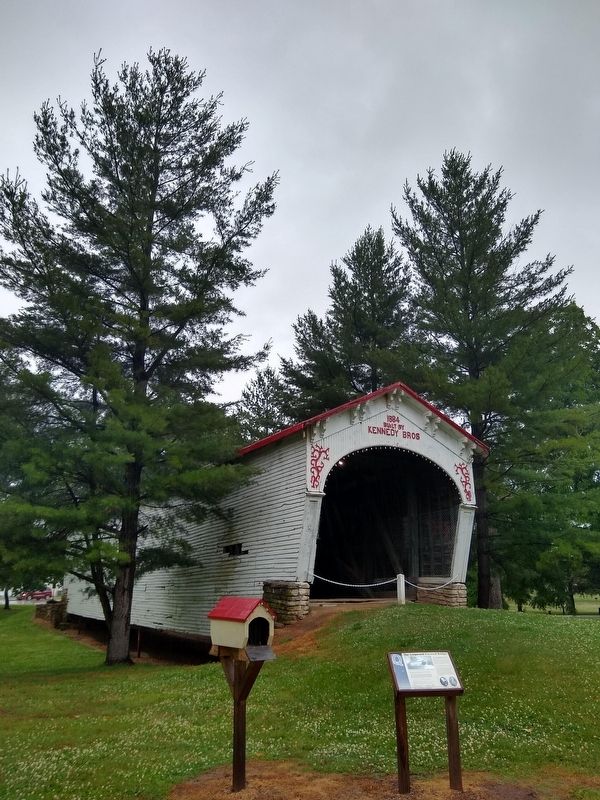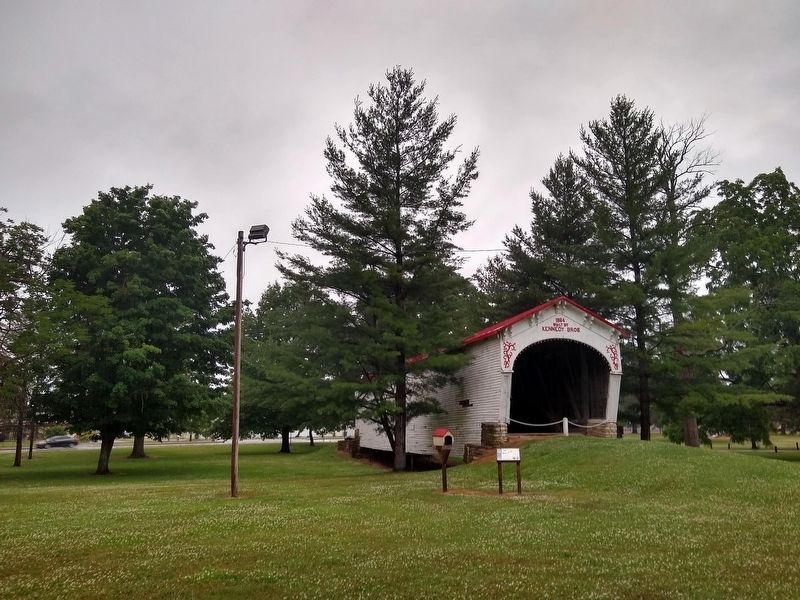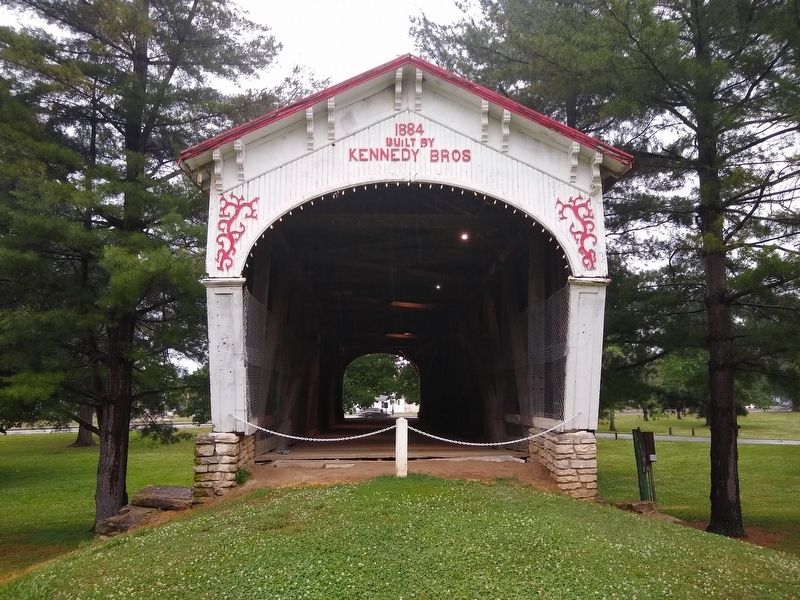Connersville in Fayette County, Indiana — The American Midwest (Great Lakes)
The Longwood Covered Bridge
The Kennedy Family
Emmett Loren Kennedy was born July 5, 1848. I 1870, he worked for his father, Archibald M. Kennedy, on the first bridge built by the Kennedy family. Upon completion of this bridge at Dunlapsville, in Union County, Indiana, Emmett became a partner with his father in the bridge building business and was business manager throughout the three-generation business of building bridges. The signage on the first bridge indicated the builder as A. M. Kennedy. After officially joining the business, the signage changed to A. M. Kennedy and Son.
It isn't clear when a second son of Archibald's, Charles Freeman Kennedy, born September 25, 1853, joined the business, but in 1871 the signage on the bridges became A. M. Kennedy and Sons.
Around 1883, Archibald withdrew from the business and Emmett and Charles became partners and the signage changed to, Kennedy Brothers. Charles was severely injured in a fall during the construction of the Circleville Bridge in Rushville in 1883, and officially withdrew from the business in 1886. the signage then changed to E. L. Kennedy and remained that was until Emmett's sons joined the firm in 1913, then it became E. L. Kennedy & Sons. Those sons ere Charles Ross Kennedy, born March 29, 1892, Karl Archibald Kennedy, born December 15, 1893, and John William Kennedy, both March 20, 1896. The last bridge built by the family was the Mitchell Bridge in Wayne County, Indiana, in 1918.
[Caption:]
The Longwood Covered Bridge was built by the Kennedy Brothers in 1884. The bridge was originally built over Williams Creek near Glenwood, Indiana, and was named for its proximity to the Longwood Station on the B&O Railroad. In 1984, on its 100th anniversary, the bridge was moved to this location in Roberts Park.
The Kennedy family of bridge builders favored the Burr arch truss system for its stability and ability to support long wood spans with little or no midstream support. This insures great strength and rigidity without excessive bulk. Shorter spans used the Howe or Multiple Kingpost truss system.
The wood favored by the Kennedy family was white pine due to its availability, its strength, and its lightness of weight so that it didn't add more actual weight to the structure. Emmett Kennedy would make periodic trips by rail to northern Michigan to contract the white pine logs and oversee the shipment back to the bridge yard in Rushville where the timbers were then transformed into the beams necessary for the specific bridge, including the boring of holes for the bolts that held the structure together. No nails were used on the structure itself. When it was time to add the flooring, roofing, and siding, then nails were used.
The structures built from 1870 to 1892 had the following characteristics:
• Decorative molding at the entrance portals on each side that alluded to Roman columns.
• Hand-carved scrollwork on the side trim of each portal.
• Hand-carved ornate corbels or brackets beneath the roof overhang gable at each entrance.
• Horizontal hung siding, to distribute the weight along the length of the bridge.
• Shingled roof.
• Siding always painted white by mixing linseed oil and shite lead in a large vat at the bridge site.
• Bridges built after 1892 did not have the first three characteristics because the Victorian era had come to an end, and those characteristics were a decorative element to reflect the influence of the Victorian time period.
Erected by The Questers.
Topics and series. This historical marker is listed in these topic lists: Bridges & Viaducts • Industry & Commerce. In addition, it is included in the Covered Bridges series list. A significant historical date for this entry is March 29, 1892.
Location. 39° 40.125′ N, 85° 7.699′ W. Marker is in Connersville, Indiana, in Fayette County. Marker can be reached from Park Road (Indiana Route 1) just south of East 28th Street, on the right when traveling north. Marker is located within Roberts Park. Touch for map. Marker is at or near this postal address: 2763 Park Rd, Connersville IN 47331, United States of America. Touch for directions.
Other nearby markers. At least 8 other markers are within 2 miles of this marker, measured as the crow flies. History of the Pavilion (about 700 feet away, measured in a direct line); The Pavilion: and other park structures (about 700 feet away); Grinding Stones (approx. ¼ mile away); James E. Roberts Memorial Building (approx. ¼ mile away); World's First County Free Fair (approx. ¼ mile away); Clio Fountain (approx. 1.2 miles away); On This Site John Conner Operated a Two Story Log Indian Trading Post 1808~1815 (approx. 1.6 miles away); "Birthplace of the Blower" (approx. 1.9 miles away). Touch for a list and map of all markers in Connersville.
More about this marker.
[Additional captions on the marker:]
Emmett Loren Kennedy Born July 5, 1848
Charles Freeman Kennedy Born September 25, 1853
Related markers. Click here for a list of markers that are related to this marker.
Credits. This page was last revised on June 28, 2020. It was originally submitted on June 27, 2020, by Tom Bosse of Jefferson City, Tennessee. This page has been viewed 502 times since then and 104 times this year. Photos: 1, 2, 3, 4. submitted on June 27, 2020, by Tom Bosse of Jefferson City, Tennessee. • Devry Becker Jones was the editor who published this page.



